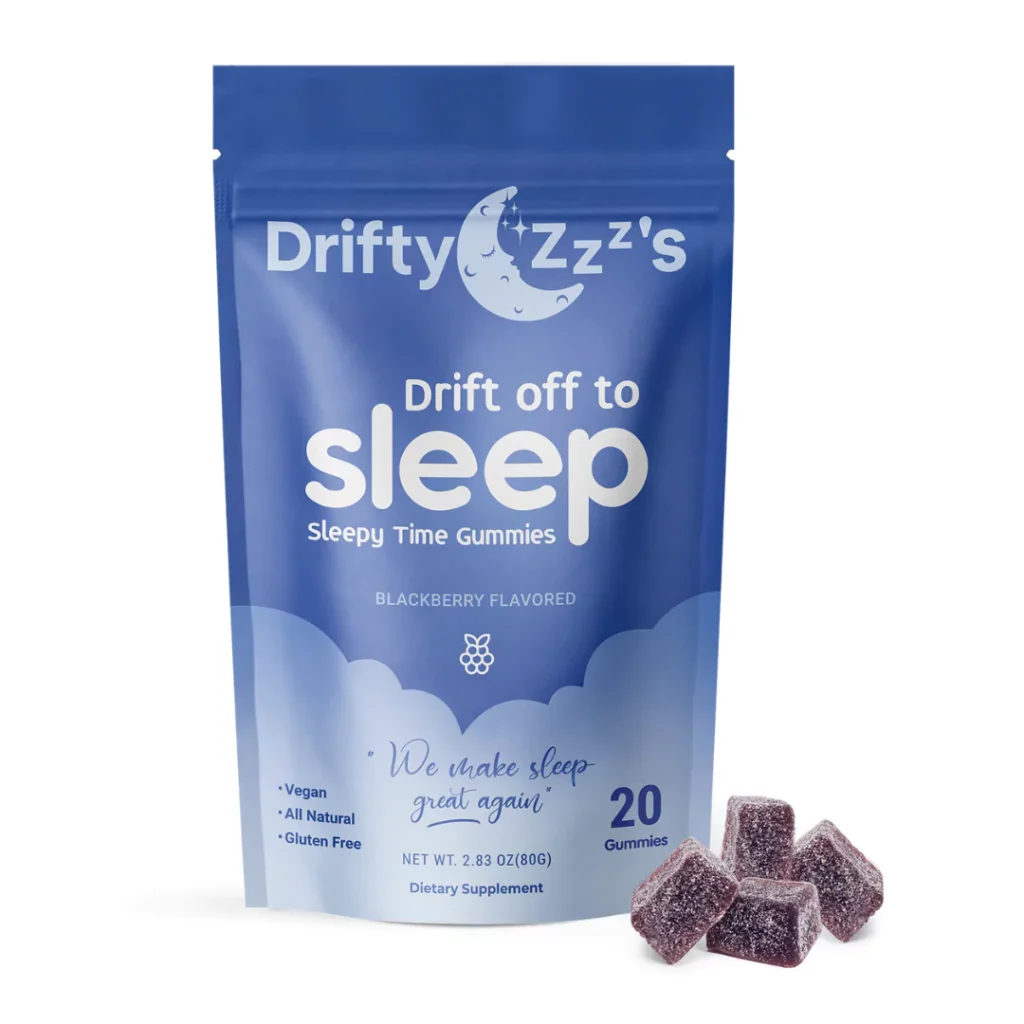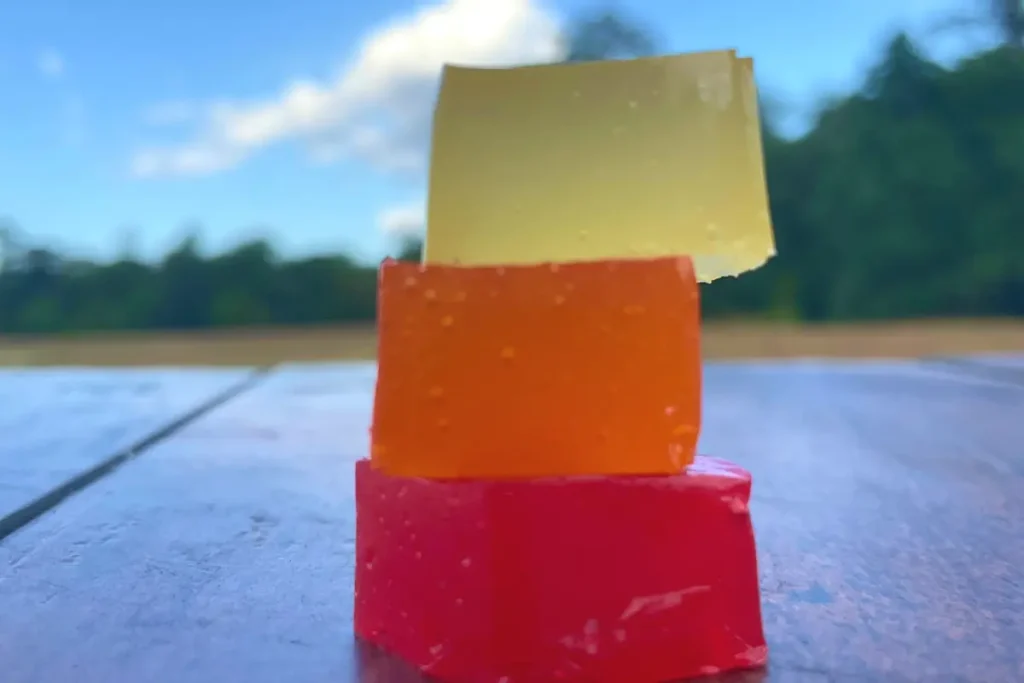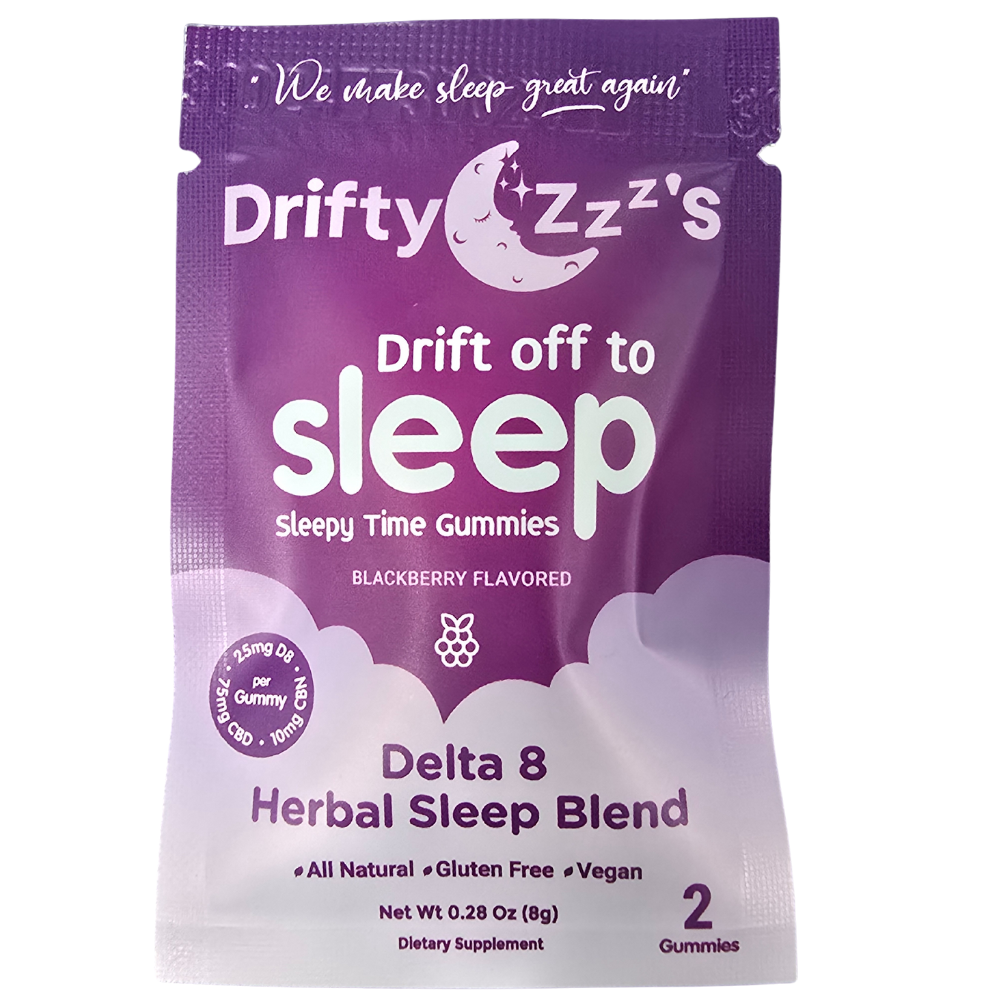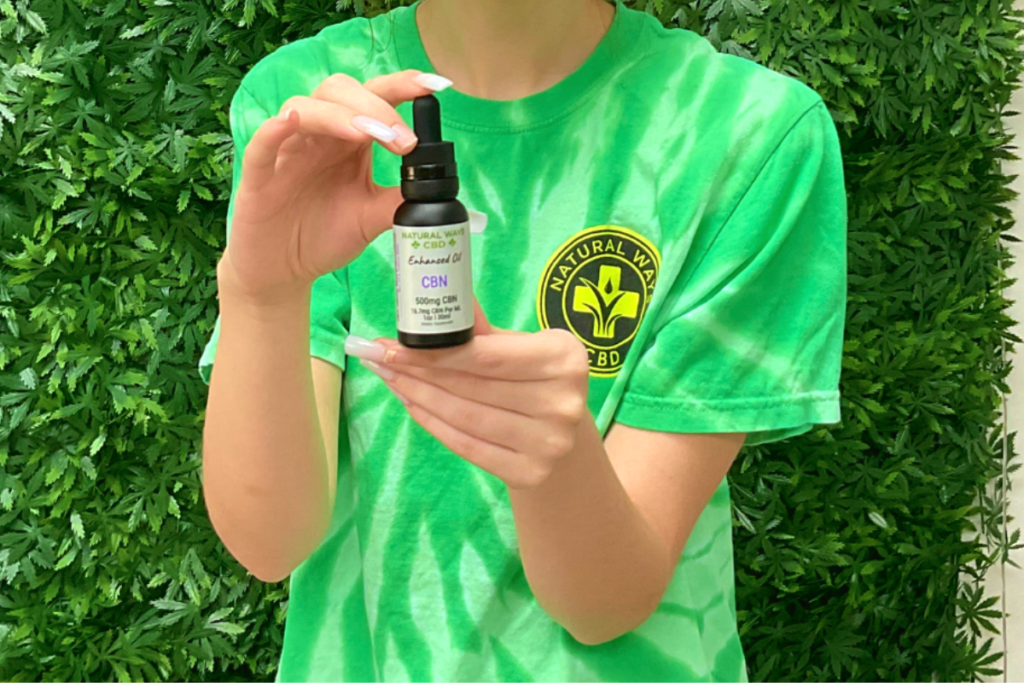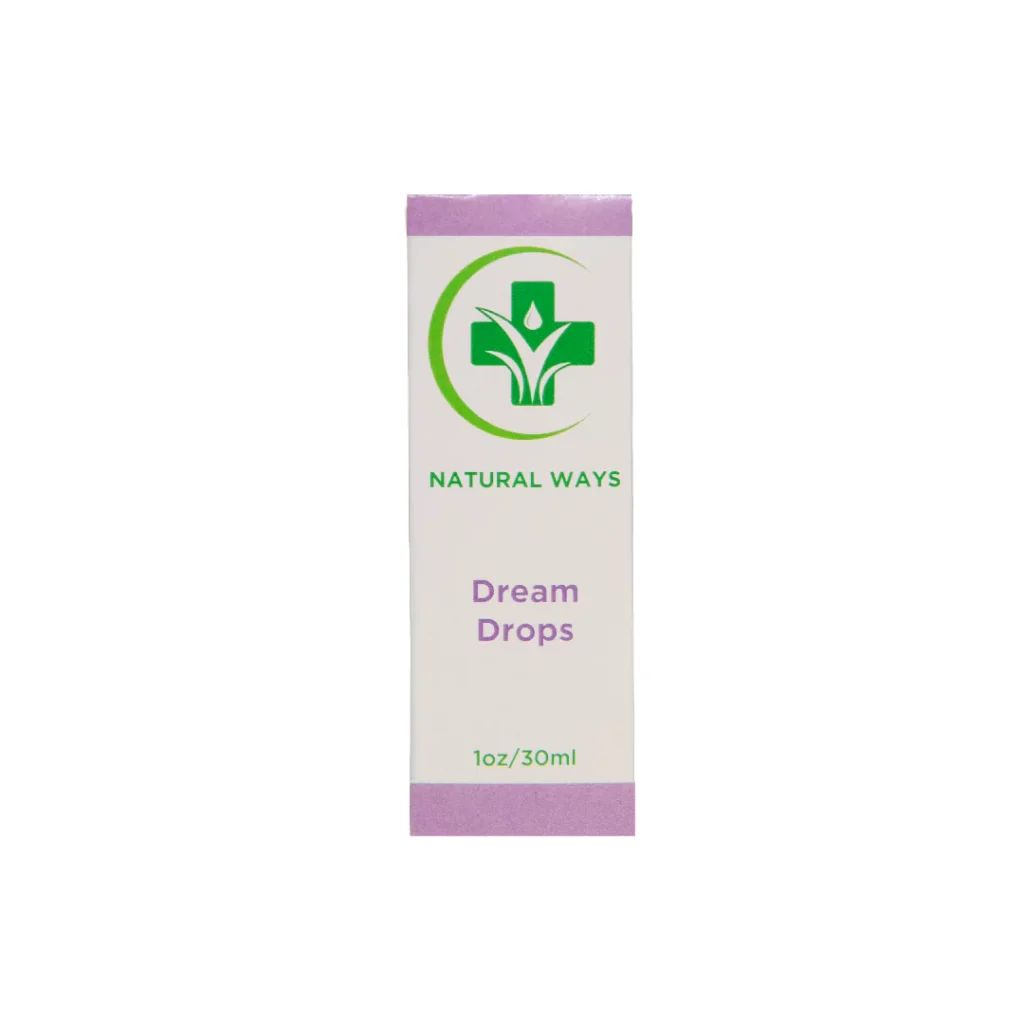Cannabinol (CBN) is a naturally occurring cannabinoid in the hemp plant that’s becoming more and more popular for therapeutic use.
Research and anecdotal evidence suggests CBN may promote restful sleep, mental relaxation, and physical comfort without creating next-day effects – and that just scratches the surface of CBN’s potential benefits.
Unlike cannabidiol (CBD), CBN is mildly psychoactive. However, it isn’t as strong as THC, which has made it popular among people who want to relax but don’t want the full THC high.
In this article, we’re going to take a look at the research-backed benefits CBN has for a variety of uses.

What is CBN?
Cannabinol (CBN) is a cannabinoid that naturally occurs in the cannabis sativa plant. Hemp is a variant of cannabis sativa containing less than 0.3% THC by dry weight.
Scientists discovered CBN nearly 100 years ago, but it was relatively unknown and unused by the general public for decades.
However, some THC users began to realize that smoking hemp flower containing high amounts of CBN along with THC produced a mellower, drowsier high than flower that didn’t contain as much CBN.
This led many people to believe that CBN has sedative properties, which has led CBN to become a popular natural sleep supplement.
But as the research shows, CBN’s benefits go far beyond sleep.
11 Research-Backed Benefits of CBN
Scientific research – much of it very recent – has found CBN to have a plethora of potential therapeutic benefits:
1. CBN for sleep
Research suggests that CBN may promote restful sleep via its sedative, mentally relaxing effects.
A 1995 study done on mice found that CBN may prolong sleeping time [1]. Anecdotally, CBN may induce a full-body sedative effect.
CBN is also commonly used as a replacement for over-the-counter melatonin supplements.
2. CBN for physical discomfort
Research suggests CBN may have analgesic (pain-reducing) and anti-inflammatory properties.
A 2016 study from University of Massachusetts researchers found CBN may have anti-inflammatory properties [2].
A 2021 study by researchers in Brazil found that CBN interacts with the CB2 receptors in the endocannabinoid system, which are capable of inhibiting pain and inflammation sensations [3].
Research out of the University of British Columbia, Canada, found that CBN reduces muscle pain in rats. The study also found that a 1:1 combination of CBD and CBN was more effective for pain than CBN alone [4].
While CBN isn’t a proven treatment for pain, inflammation, and related conditions, anecdotal evidence suggests it has therapeutic potential for promoting physical relaxation.
3. CBN for focus
Research suggests CBN has therapeutic potential to promote focus.
A 2020 study that looked at the impact of cannabinoid and terpene consumption on ADHD found that a high dosage of CBN was associated with a lower Adult ADHD Self-Report Scale (ASRS) score [5].
While CBN isn’t a treatment for ADHD, this study suggests that it may have calming, balancing effects on the mind.
4. CBN for eye health
Research suggests CBN may promote eye health.
A 2021 study from the University of British Columbia, Canada, found that CBN promoted neuroprotection and normalized intraocular pressure levels in the eye [6].
CBN isn’t a proven treatment for glaucoma and other eye conditions, but early studies suggest it may help maintain healthy eyes.
5. CBN for appetite stimulation
Studies have found that CBN may have appetite-stimulating effects.
In 2012 study done on rodents, CBN reduced the time it took rats to begin eating and increased the amount of food they consumed [7].
This research suggests CBN may have therapeutic potential in situations where low appetite is a factor.
6. CBN for cell health
Research suggests CBN may have anti-tumor properties.
In a 2023 study, CBN reduced proliferation of several types of cancer cells [8].
While CBN is by no means a proven cancer treatment, this early study suggests that more research should be conducted in this area.
7. CBN for seizures
Research suggests CBN may have anticonvulsant properties, indicating that it has therapeutic potential for seizures.
In a 1973 study, CBN was shown to be an effective anticonvulsant in mice [9].
A 2020 study found that CBN exerted anti-seizure properties in one model but didn’t in another model, suggesting it may work differently for different types of seizures [10].
These mixed results indicate that, while CBN has therapeutic potential in this area, more studies are needed before we have definitive knowledge of how it impacts seizures.
8. CBN for bone health
Research suggests CBN may have supportive effects for the bones.
A 2009 study found that the CB2 receptors in the endocannabinoid system are a potential therapeutic target for reducing bone loss [11]. CBN is an agonist of CB2, so it may offer this therapeutic benefit.
However, more research is needed before we know whether CBN can help treat bone loss.
9. CBN for neurological health
Research suggests CBN may have neuroprotective properties.
A 2024 study by scientists at the Salk Institute found that CBN-based compounds protected the brain against aging and neurodegeneration [12].
While CBN isn’t a treatment for neurodegenerative diseases, this study suggests CBN has therapeutic potential in this area and should be researched further.
10. CBN for bacteria resistance
Research suggests CBN may have antibacterial properties.
In a 2008 study that looked at the antibacterial activity of five cannabinoids, CBN was shown to have potent activity against several disease strains [13].
CBN isn’t a proven treatment for bacterial infections and conditions, but this study suggests it has therapeutic potential in this area.
11. CBN for recreation
Research suggests CBN may enhance the effects of tetrahydrocannabinol (THC).
A 1975 study found that a CBN-THC combination will render a greater psychoactive effect than THC alone [14].
Anecdotal accounts corroborate this; most people describe this effect as a calmer, drowsier version of the normal THC high.
Taking CBN and THC together may have therapeutic potential for sleep and relaxation.
CBN Benefits Chart
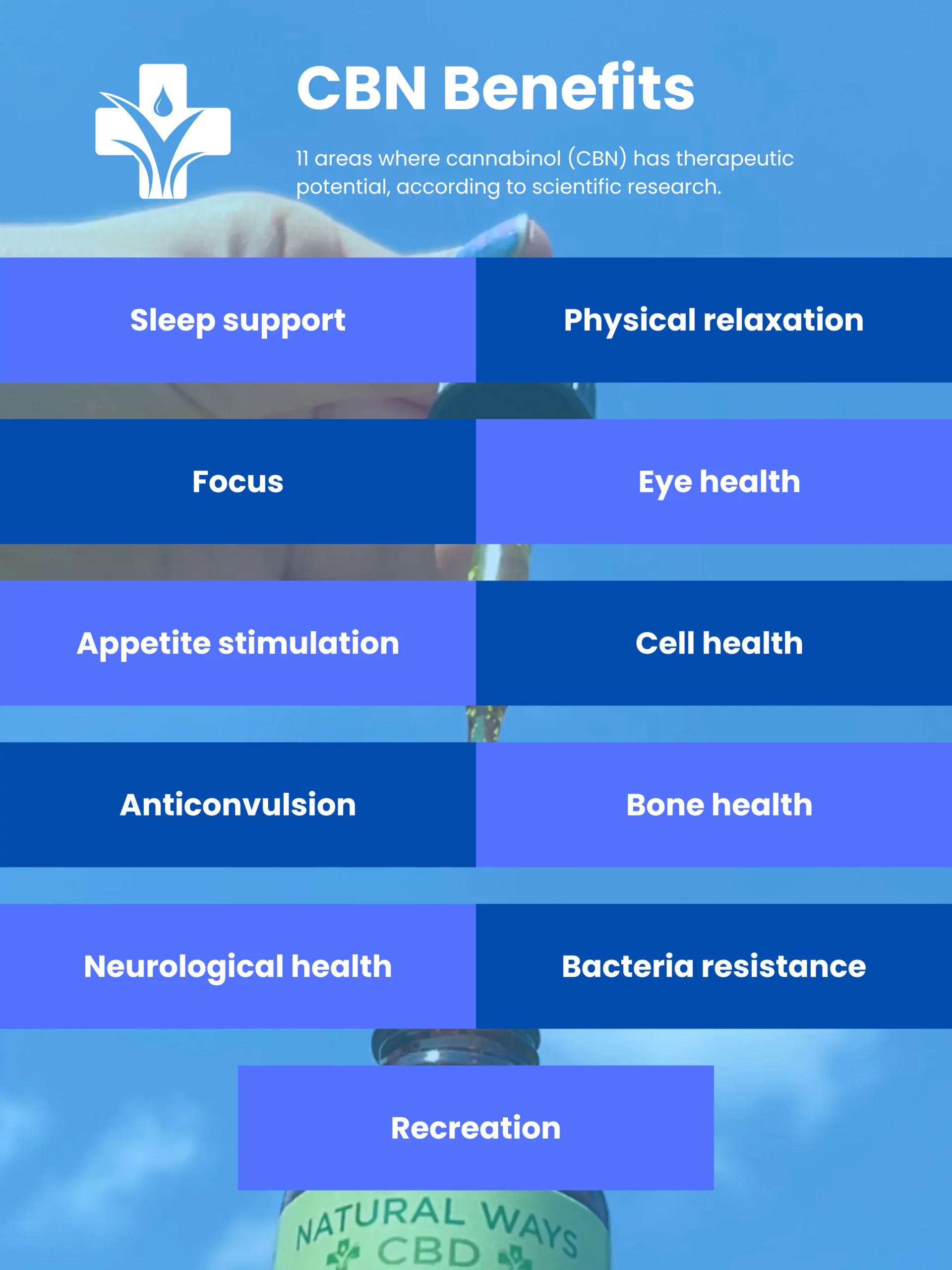
Side Effects of CBN
While CBN has many potential therapeutic benefits, it also may create some side effects.
Potential side effects of CBN include:
- Changes in appetite
- Dizziness
- Tiredness
- Upset stomach
- Dry mouth
In many cases, these side effects are minimal if you start with a low dose of CBN and gradually work your way up.
Conclusion: CBN’s Therapeutic Potential
While research on CBN began over 50 years ago, scientists have been researching CBN more than ever in recent years. And based on what they’ve found, it seems CBN has immense therapeutic potential.
Future research will help determine uses where CBN has the potential to be developed as a medication. But this is largely dependent on the legalization of cannabis.
In the meantime, you can still use CBN as a therapeutic supplement to support your mental and physical health.
CBN Benefits: Frequently Asked Questions
Here are some questions our customers frequently ask us about the benefits of CBN.
What does CBN do in the body?
CBN may promote both mental and physical relaxation and create a mild psychoactive effect. CBN creates these effects by interacting with your body’s endocannabinoid system.
What does CBN do to the brain?
Research suggests CBN has neuroprotective properties for the neurons in your brain.
What does CBN make you feel like?
CBN makes you feel relaxed, slightly high, and slightly drowsy. These effects have made it popular for sleep support, but it’s good for many other therapeutic uses, especially in combination with other cannabinoids.
Is CBN better for sleep?
Yes, CBN is one of the better cannabinoids in hemp for sleep support. It’s stronger and more sedative than CBD, but it’s less psychoactive and less likely to cause next-day effects than THC.
Does CBN get you high?
Yes, CBN will get you slightly high. It creates a drowsy high that’s about ¼ as potent as that of THC.
Does CBN have side effects?
Yes. Potential side effects of CBN include changes in appetite, dizziness, tiredness, upset stomach, and dry mouth.
Sources
[1] Yoshida, H et al. “Synthesis and pharmacological effects in mice of halogenated cannabinol derivatives.” Chemical & pharmaceutical bulletin vol. 43,2 (1995): 335-7. doi:10.1248/cpb.43.335
[2] Zurier, Robert B, and Sumner H Burstein. “Cannabinoids, inflammation, and fibrosis.” FASEB journal : official publication of the Federation of American Societies for Experimental Biology vol. 30,11 (2016): 3682-3689. doi:10.1096/fj.201600646R
[3] Campos, Raquel Maria P et al. “Cannabinoid Therapeutics in Chronic Neuropathic Pain: From Animal Research to Human Treatment.” Frontiers in physiology vol. 12 785176. 30 Nov. 2021, doi:10.3389/fphys.2021.785176
[4] Wong, Hayes, and Brian E Cairns. “Cannabidiol, cannabinol and their combinations act as peripheral analgesics in a rat model of myofascial pain.” Archives of oral biology vol. 104 (2019): 33-39. doi:10.1016/j.archoralbio.2019.05.028
[5] Hergenrather, Jeffrey Y et al. “Cannabinoid and Terpenoid Doses are Associated with Adult ADHD Status of Medical Cannabis Patients.” Rambam Maimonides medical journal vol. 11,1 e0001. 30 Jan. 2020, doi:10.5041/RMMJ.10384
[6] Somvanshi, Rishi K et al. “Cannabinol modulates neuroprotection and intraocular pressure: A potential multi-target therapeutic intervention for glaucoma.” Biochimica et biophysica acta. Molecular basis of disease vol. 1868,3 (2022): 166325. doi:10.1016/j.bbadis.2021.166325
[7] Farrimond, J. A., Whalley, B. J., & Williams, C. M. (2012). Cannabinol and cannabidiol exert opposing effects on rat feeding patterns. Psychopharmacology, 223(1), 117–129. https://doi.org/10.1007/s00213-012-2697-x
[8] Farrimond, J. A., Whalley, B. J., & Williams, C. M. (2012). Cannabinol and cannabidiol exert opposing effects on rat feeding patterns. Psychopharmacology, 223(1), 117–129. https://doi.org/10.1007/s00213-012-2697-x
[9] Karler, R., Cely, W., & Turkanis, S. A. (1973). The anticonvulsant activity of cannabidiol and cannabinol. Life sciences, 13(11), 1527–1531. https://doi.org/10.1016/0024-3205(73)90141-0
[10] Thornton, C., Dickson, K. E., Carty, D. R., Ashpole, N. M., & Willett, K. L. (2020). Cannabis constituents reduce seizure behavior in chemically-induced and scn1a-mutant zebrafish. Epilepsy & behavior : E&B, 110, 107152. https://doi.org/10.1016/j.yebeh.2020.107152
[11] Bab, I., Zimmer, A., & Melamed, E. (2009). Cannabinoids and the skeleton: from marijuana to reversal of bone loss. Annals of medicine, 41(8), 560–567. https://doi.org/10.1080/07853890903121025
[12] Liang, Z., Candib, A., Soriano-Castell, D., Fischer, W., Finley, K., & Maher, P. (2024). Fragment-based drug discovery and biological evaluation of novel cannabinol-based inhibitors of oxytosis/ferroptosis for neurological disorders. Redox biology, 72, 103138. https://doi.org/10.1016/j.redox.2024.103138
[13] Appendino, G., Gibbons, S., Giana, A., Pagani, A., Grassi, G., Stavri, M., Smith, E., & Rahman, M. M. (2008). Antibacterial cannabinoids from Cannabis sativa: a structure-activity study. Journal of natural products, 71(8), 1427–1430. https://doi.org/10.1021/np8002673
[14] Karniol, I G et al. “Effects of delta9-tetrahydrocannabinol and cannabinol in man.” Pharmacology vol. 13,6 (1975): 502-12. doi:10.1159/000136944

